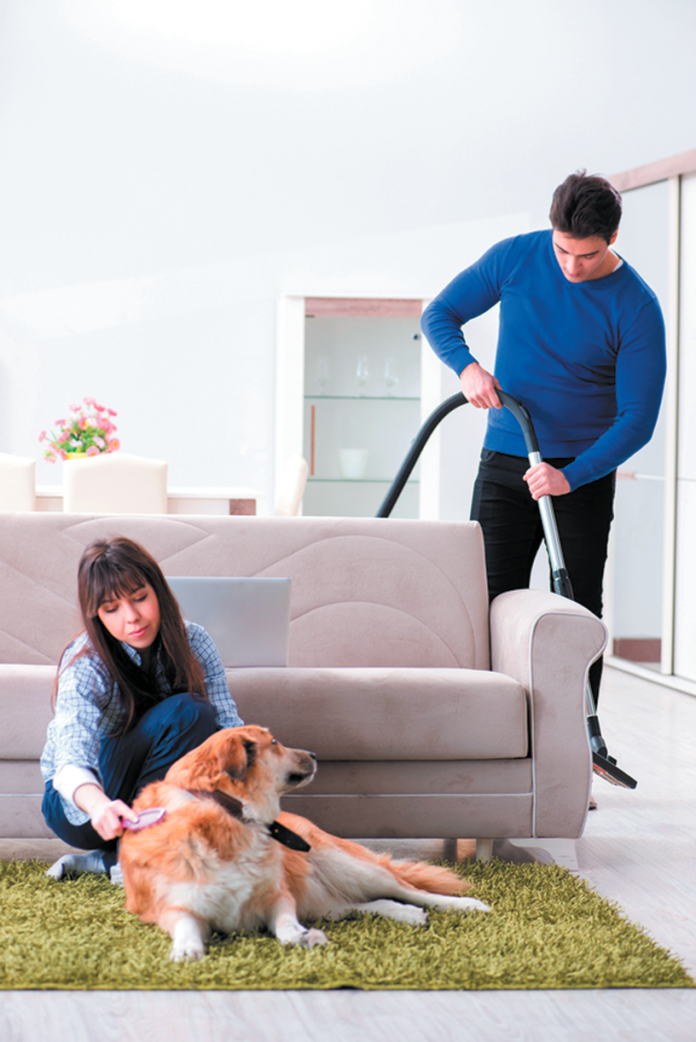Come on, admit it. While you may not be able to smell dog odor in your home because you’ve become too accustomed to it, you’ve worried on occasion that visitors can.
Here are nine foolproof tips for minimizing, or even getting rid of, your house’s doggie scent, whether or not it’s strong to you.
1. You can’t vacuum enough — every two to three days if your dog is particularly furry or long-haired, or if you have more than one. All that hair and the dander it carries trap odors, and vacuuming helps keep the dog scent to a minimum. Don’t limit vacuuming to rugs and carpets. Make sure you also get to upholstered furniture, drapes, and any other materials that can take the suction of a vacuum wand. Move furniture to get behind it. And empty the canister immediately upon finishing. Otherwise, your vacuum cleaner canister becomes your home’s air “freshener.”
Helpful hint: Sprinkle some baking soda under couch cushions and mattresses and leave it there for up to 12 hours before before vacuuming it up. Baking soda “soaks up” undesirable odors not just in the fridge but also in and near spaces where your dog hangs out.
2. Mop hardwood and linoleum floors once or twice a week. If you sweep only, it might seem like you have gotten rid of the problem by having swept away the hair and dander. But saliva and sweat come off a dog’s paws and can stick to hardwood.
3. Throw everything in the washing machine that you can — not just bed linens but also slip covers, curtains, throw pillows. Even if your dog is not allowed on the furniture or beds in the house, her odors will reach those places. Dander and scent molecules have a way of getting around. A wet wash with a good detergent will go a long way toward neutralizing any odors. Make sure everything’s fully dry before putting it back on furniture; wet cloth attracts odors.
4. Wash your dog’s bedding, toys, food and water bowls, leash, and collar or harness regularly. While we know to keep our own belongings clean, it’s all too easy to forget that a dog’s stuff, even if it’s all kept neatly in a corner, is what’s most apt to fill a home with unwanted scents. After all, these things make direct contact with your dog’s fur and mouth on a more frequent basis than anything else, so of course they’re going to build up odors.
5. Bathe your dog. Generally speaking, dogs don’t need to be bathed for their health. But you need for them to be bathed to rid them of some of the odor(s) they carry around. You don’t want to overdo it. Dogs are literally more thin-skinned than we are. But every month or two won’t hurt, as long as you use a gentle shampoo made for dogs.
6. Crack open a window. In our carbon footprint-conscious times, houses are being built tighter and tighter to conserve heat or coolness, depending on the season and the locale, and that’s all to the good for protecting the planet. But a little air exchange, with some air flowing out of the house and some new air flowing in, not only releases “stuck” odors but also is good for us, as well as our pets. You have to use common sense. It may not be a good idea to throw open any windows in Phoenix in July or in Duluth in January, but here and there….
7. Change air filters regularly, even more often than the manufacturer advises if you have a long-haired dog or one that sheds a lot. It’s not so much that your dog’s hairs get trapped in the filter and spread odors around the house that way. It’s that the trapped hairs keep air from circulating as freely, so smelly air stagnates more easily.
8. Brush your dog’s teeth every day. You’ve smelled your dog’s breath, yes? Good oral hygiene in general, including regular dental check-ups when she visits the vet and under-the-gum-line cleanings and other necessary procedures, will help reduce nasty dog odors in your home.
9. Clean your dog’s ears. Bacteria and yeast can attach to the wax buildup that can occur in a dog’s ears, particularly if they’re floppy, and can make for an unpleasant scent. But don’t use a Q-tip to get rid of the dirt. It can push wax further in and even puncture a dog’s eardrum if inserted too forcefully. Instead, use a dropper to apply an over-the-counter cleaning solution like Epi-otic or Otoclean. The dog will not like the fluid and will shake her head until it comes out — with the dirt. Once every week or two should do the trick. (Prick ears, like those on German shepherds, generally don’t need to be cleaned.)





